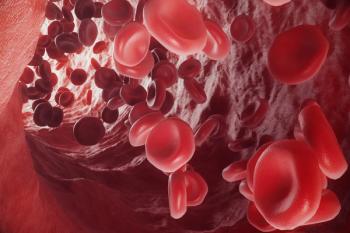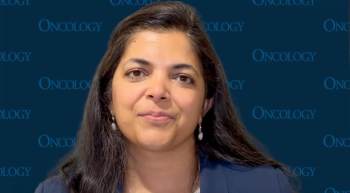
Exploring First-Line ALK Inhibitors, TKI Sequencing in ALK-Positive NSCLC
Given an unmet need for efficacious therapies against ALK-positive NSCLC, experts discuss optimal ALK TKI sequencing for patients with this disease.
ALK-positive lung cancer, which accounts for approximately 4% of lung cancer diagnoses and is generally found in non–small cell lung cancer (NSCLC), typically impacts patients who are younger than the average patient diagnosed with lung cancer, as well as those who have no history of smoking.1 Treatment options for this disease type currently include chemotherapy, immunotherapy, and radiation therapy; however, for early-stage disease or first-line therapy, patients are typically given a tyrosine kinase inhibitor (TKI) that selectively targets the ALK gene, called an ALK inhibitor.
Currently, the NCCN guidelines list 6 ALK TKIs for use as a first-line treatment for ALK-positive NSCLC, the first 4 of which are preferred, the latter 2 of which are useful for patients with a performance status score of 0-4: alectinib (Alecensa), brigatinib (Alunbrig), ensartinib (Ensacove), lorlatinib (Lorbrena), ceritinib (Zykadia), and crizotinib (Xalkori).2 Subsequent therapy options for ALK inhibition include the aforementioned agents, excluding crizotinib, with lorlatinib listed as an option for resistant mutations, excluding compound L1196M/G1202R.
Given the multiplicity of options, most of which are preferred, CancerNetwork® discussed optimal sequencing strategies for patients with oncologists specializing in NSCLC. Jonathan Riess, MD, MS, director of Thoracic Oncology and associate professor of Medicine at the University of California Davis Comprehensive Cancer Center, suggested that lorlatinib may be the optimal therapy given its unprecedented progression-free survival (PFS) outcomes. Another oncologist specializing in lung cancer, Misako Nagasaka, MD, PhD, an associate clinical professor of medicine in the Division of Hematology and Oncology at the University of California, Irvine (UCI) School of Medicine of UCI Health, concurred, highlighting that the outcomes reported in the
Phase 3 CROWN Trial Survival Data
Data showcasing the efficacy of lorlatinib from the
“The CROWN trial was pivotal in the treatment of ALK-positive lung cancer. It was a randomized, global phase 3 study looking at patients with metastatic NSCLC whose tumors harbor an ALK rearrangement. [Lorlatinib] was the first line [treatment for ALK-positive NSCLC].” Riess said during the interview. “A post hoc analysis at 5 years showed an impressive PFS benefit [with lorlatinib]. Median PFS at 5 years was not reached [NR; 95% CI, 64.3-NR], and 60% of patients had not progressed. [These were] unprecedented results in lung cancer; the HR was 0.19 [95% CI, 0.13-0.27] …. a very significant study.”
Compared with lorlatinib, crizotinib elicited a median PFS of 9.1 months (95% CI, 7.4-10.9) and a 5-year PFS rate of 8%. The median duration of follow-up in the lorlatinib and crizotinib arms was 60.2 months (95% CI, 57.4-61.6) and 55.1 months (95% CI, 36.8-62.5), respectively.
“This is a fantastic result [with lorlatinib] that we usually never get to see in solid tumors, and it was exciting to see,” Nagasaka expressed during the conversation. “It feels like, at least for some subsets of [patients with] NSCLC, we are now able to start treating them more like [if they had] a chronic disease. It’s exciting to be in a time when this is all happening.”
Ascertaining CNS Benefit With ALK TKIs in ALK-Positive NSCLC
According to Nagasaka, lorlatinib shows particularly strong intracranial objective response, and a similar trend was observed with alectinib and brigatinib in the phase 3 ALEX (NCT02075840) and ALTA-1L (NCT02737501) trials for patients with ALK-positive NSCLC. However, CROWN data revealed that lorlatinib showed improvement in decreasing the risk of central nervous system (CNS) progression.
“We know from earlier studies…. that lorlatinib penetrates the brain very well. We also know from the frontline studies of CROWN, ALEX, and ALTA-1L trials, [that] the intracranial objective response rates and intracranial complete response rates were similar between the 3 ALK-TKIs,” Nagasaka explained. “There is this key distinguishing benefit of lorlatinib that was reported from the CROWN update: its unprecedented decrease in the risk of CNS progression compared with what was previously reported with alectinib and brigatinib.”
Additional CROWN data revealed that the median time to intracranial progression in patients with brain metastases in the lorlatinib and crizotinib arms was NR (95% CI, NR-NR) vs 7.2 months (95% CI, 3.7-11.0), respectively (HR, 0.03; 95% CI, 0.01-0.13). Patients with brain metastases at baseline experienced a median PFS of NR (95% CI, 32.9-NR) and 6.0 months (95% CI, 3.7-7.6) with the respective agents (HR, 0.08; 95% CI, 0.04-0.19). Furthermore, the 5-year probability of intracranial PFS was 83% (95% CI, 64%-93%) among those treated with lorlatinib; it was not evaluable with crizotinib, given all patients experienced progression in the brain or were censored before 2 years on study.
Of note, Nagasaka considers lorlatinib for patients who do not have brain metastases at baseline, in large part due to the agent’s CNS protective properties.
“I consider using lorlatinib even in patients who don’t have a baseline brain metastasis just because of the protective effect lorlatinib might have against the development of brain metastasis, and that’s something you want to avoid as an oncologist,” she said.
Additional CROWN data shows similar CNS benefit among patients without brain metastases at baseline. Findings among the lorlatinib and crizotinib groups showed that the HR for time to intracranial progression was 0.05 (95% CI, 0.02-0.13) favoring lorlatinib; the probability of preventing brain metastases was 96% (95% CI, 89%-98%) vs 27% (95% CI, 14%-43%); and the median PFS was NR (95% CI, 64.3-NR) vs 10.8 months (95% CI, 9.0-12.8) with each agent, respectively.
Distinguishing ALK TKI Safety in the Frontline Setting
The adverse effect (AE) profiles of individual ALK TKIs appear to be well tolerated according to Riess, but some unique AEs emerge with individual agents.
“There are some unique AEs [such as] elevated lipids and some neurologic AEs,” Riess explained. “You also need to monitor liver function. There could be some edema. Other ALK TKIs have had good AE profiles. [With] alectinib, I have to monitor liver function tests [LFTs]. There could be some weight gain as well, but overall, [it is] generally well-tolerated.”
Furthermore, Riess suggested that dose de-escalation with ALK TKIs may help to reduce treatment-related AEs without sacrificing treatment efficacy. He expressed that although the FDA-approved dose for lorlatinib was 100 mg, an early dose reduction to 75 mg did not appear to have a significant impact on the efficacy of the agent.
Despite the limitations of cross-trial comparison among preferred ALK TKIs, Nagasaka deduced that no unexpected toxicities were observed with lorlatinib treatment. However, lorlatinib elicited a greater number of grade 3 to 5 AEs over brigatinib or alectinib in cross-trial comparisons, with notable AEs including hyperlipidemia, weight gain, and the potential for long-term cardiovascular AEs.
“In conjunction [with] the issue with hyperlipidemia, this might raise the concern of long-term risk of cardiovascular disease among patients using lorlatinib for many years as a frontline therapy. However, as far as we are aware at the 5-year follow-up, [of the CROWN trial], there was no increase in cardiovascular events with lorlatinib across all patients. [What is] more important would be the longer follow-up to tease that out,” Nagasaka stated.
According to Misako, CNS toxicities may pose a greater threat than hyperlipidemia when treating patients, which has been observed in previous studies evaluating lorlatinib. CROWN study safety results revealed that most of these toxicities were lower grade, grades 1 or 2, and that most patients did not require dose reductions or discontinuations due to these events.
“[Patients] were able to continue the drug at the same dose, and the CNS AE subsided on their own. It is only a portion of the patients who receive lorlatinib who have a CNS toxicity that needs to be managed with either a drug hold or drug reduction,” she concluded. “They are still there, and it’s important to make sure we don’t miss these patients. Counseling patients and family members on the possibility of these CNS toxicities remains key.”
Elucidating Preferred TKI Sequencing in ALK-Positive NSCLC
Despite multiple studies showing alectinib, brigatinib, and lorlatinib showing a substantial PFS benefit over crizotinib, as well as an FDA approval for ensartinib, Riess prefers lorlatinib.4
“For me, it is the magnitude of the PFS benefit, the magnitude of the intracranial activity, and an appreciation for the potential AEs. That is where I discuss these options with my patients…. I often consider lorlatinib,” he explained.
Riess explained that he will also consider the use of alectinib as first-line treatment but will decide between that and lorlatinib based on the AE profile within the context of individual patients.
“There are other patients who were looking at alectinib or [another ALK TKI] based on the AE profile, and so forth may also make sense as a choice,” he remarked. “I discuss these regimens with my patients who have ALK-positive [disease] in terms of selecting the best ALKinhibitor for them.”
Nagasaka expressed that she primarily considers lorlatinib for most of her patients, due to its strong PFS data, but is cognizant of discussing the risks and benefits of individual therapies with patients and family members. One consideration she discussed was regarding one’s family situation, which may impact the feasibility of certain therapies based on their safety profiles.
“If you’re a taxi driver who must make quick decisions [daily], and you are living alone, you’re completely independent. There is nobody else to look [after you] if you were to have a CNS-related AE,” she explained. “In those patients, I am a bit more cautious about using a medication like lorlatinib. Just because a drug has a known AE, it doesn’t necessarily mean that it’s always going to happen to these patients.”
Highlighting Future Considerations for ALK-Positive NSCLC Treatment
When asked about developments in treatment for this patient population that have the potential to impact clinical practice, both Riess and Nagasaka highlighted early clinical data with NVL-655, a next-generation ALK TKI, in the phase 1/2 ALKOVE-1 trial (NCT05384626) presented at the
The investigational therapy showed an objective response rate of 38% (n = 39/103) among patients who were heavily pretreated with ALK-positive tumors, including 55% (n = 30/55) among patients with an ALK mutation, and 49% (n = 23/47) among those who received prior lorlatinib therapy. In respective groups, the duration of response was 9.2 months (95% CI, 6.9-not evaluable [NE]), 14.4 months (95% CI, 6.9-NE), and 14.4 months (95% CI, 6.9-NE). Furthermore, a maximum tolerated dose was not reached, with 150 mg once daily selected as the recommended phase 2 dose.
Riess further highlighted a need to enhance the efficacy of immunotherapy in patients with ALK-positive NSCLC, citing underwhelming results with immune checkpoint inhibitors not seen with smoking-associated lung cancers. By contrast, he touched upon promising results seen in vaccine-based approaches, emphasizing an ALK peptide vaccine, which may help restore immunogenicity in ALK rearrangements. Reiterating the unmet need for immunotherapy options for this patient group, he stated that the vaccine was one of many immunotherapy approaches under development for ALK-positive NSCLC.
References
- ALK and Lung Cancer. American Lung Association. Updated January 22, 2025. Accessed May 14, 2025. https://tinyurl.com/mz6a8zry
- NCCN. Clinical Practice Guidelines in Oncology. Non–small cell lung cancer, version 3.2025. Accessed May 14, 2025. https://tinyurl.com/mtdckuje
- Solomon BJ, Liu G, Felip E, et al. Lorlatinib vs crizotinib in treatment-naïve patients with advanced ALK+ non-small cell lung cancer: 5-year progression-free survival and safety from the CROWN study. J Clin Oncol. 2024;42(suppl 17):LBA8503.
- FDA approves ensartinib for ALK-positive locally advanced or metastatic non-small cell lung cancer. News release. FDA. December 18, 2024. Accessed May 14, 2025. https://tinyurl.com/yy8e6bd6
- Drilon AE, Lin JJ, Johnson ML, et al. Phase I/II ALKOVE-1 study of NVL-655 in ALK-positive (ALK+) solid tumours. Presented at: 2024 ESMO Congress; September 13-17, 2024; Barcelona, Spain. Abstract 1253O.
Newsletter
Stay up to date on recent advances in the multidisciplinary approach to cancer.

















































































